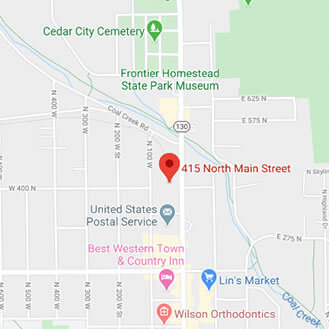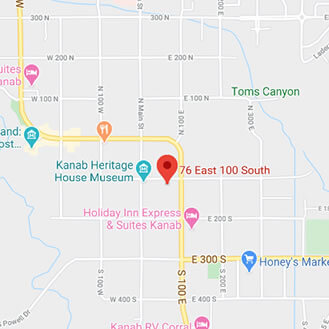October 14th, 2015

You may have noticed that kids seem to be getting braces and other orthodontic care a lot earlier these days. There was a time, only a decade or two ago, when braces were mainly seen on teenagers, but that is beginning to change. If you’re wondering when to bring your child to our Cedar City or Kanab, UT office for an orthodontic evaluation, the answer actually has several parts.
The Telltale Signs
If your child has a very crowded set of adult teeth coming in, or if the permanent front teeth came in very early, these are signs that your child should see Dr. Mark Webster, regardless of age.
The Dental Age
Barring signs of trouble or early adult teeth as mentioned above, the time that your child needs to be seen for initial orthodontic evaluation depends not so much upon your child’s actual age, but on what is known as a “dental age.”
The dental age of the patient might be entirely different from his or her actual chronological age; for example, an eight-year-old could have a dental age of 13. It is part of Dr. Mark Webster and our staff’s job to determine the dental age and then make appropriate recommendations for the resolution of orthodontic issues if they are emerging.
The Official Recommended Age
The American Association of Orthodontists officially recommends that kids should see an orthodontist for the first time between the ages of seven and nine. Even if the child does not have all his or her permanent teeth, the teeth growth pattern can usually be predicted quite effectively by an orthodontist.
This allows for a proactive response to emerging problems, and this is the reason that some younger children are now getting orthodontic devices earlier in life. If a young child has serious orthodontic issues emerging, Dr. Mark Webster can usually address the problems immediately and then follow up with another round of treatment when the child has all the adult teeth.
October 7th, 2015

What does the month of October mean to you? For people in the northern hemisphere, October is when the weather starts to get a little chilly: heavy jackets might come out of storage and the summer clothing gets packed away. You might start making plans for the upcoming holidays or looking at the beautiful and changing autumn scenery. October means something a little different to our team at Webster Orthodontics because this is National Orthodontic Health Month. During October, orthodontic clinics all over the country work together to promote their services and inform the community about the important work we do.
National Orthodontic Health Month is an awareness campaign created cooperatively by orthodontists and other dental health professionals. During this month, we make a special effort to promote dental health and orthodontic health in particular. This is a great time to get your questions answered by dental professionals in your community and to learn more about exactly what an orthodontist can do for you and your family. Events held in connection with National Orthodontic Health Month are also an opportunity for us orthodontists to come out and meet community members. If you have never been to an orthodontist before, you might not know what to expect. Meeting one of us in person before your checkup is a great way to find out what kind of person you’ll be seeing during your appointment.
Meeting Dr. Mark Webster in a relaxed “meet and greet” atmosphere can be especially helpful for any young orthodontic patients in your family. Kids of all ages–and their parents!–can feel anxiety about going to the dentist. Getting to know the person you have an appointment with can make the experience a lot less stressful for everyone. We don't want anyone to avoid seeing a dental professional for regular checkups just because they don't know who we are. Just meeting and talking with the orthodontist you'll be seeing may be enough to make you feel more comfortable about your upcoming appointment.
Dental health is something that affects everyone; healthy teeth and gums contribute to a healthy smile and a lifetime of comfort and well-being. Orthodontists are just one of the various dental practitioners you could visit at some point in your life, so taking a little time to learn who we are and what we do is certain to be a helpful experience. We look forward to seeing you and your family this October at our Cedar City or Kanab, UT location!
September 30th, 2015

Although teeth seem to be solidly fixed in their sockets (at least they don’t wobble when we chew!), all teeth can easily be moved if Dr. Mark Webster and our staff attach brackets and wires to them called braces. In the past, all braces were made of stainless steel, but today’s advanced dental technology gives people the option of wearing transparent, acrylic mouth trays called Invisalign®, or relying on traditional metal braces for correcting malocclusions.
Brackets, Slots, and Arch Wires – Oh My!
When light pressure is consistently exerted on teeth, they will gradually move in the direction of the force. For example, affixing brackets to front teeth and threading a flexible, metal wire through tiny slots on the front of the brackets allows the orthodontist to tighten this arch wire enough to initiate desired movement of teeth. Generally, orthodontic patients visit Webster Orthodontics once a month to have this wire tightened to keep teeth moving in the desired direction.
Tissues surrounding the teeth that experience pressure from arch wires will slowly (and, for the most part, painlessly) stretch, and allow the socket to enlarge so the tooth and its root become looser temporarily. This allows the root to move without causing bleeding or pain. Once Dr. Mark Webster and our staff are satisfied with the repositioning of teeth, we will remove the braces and let bone material fill in the socket so that teeth are solidified into their new (and straighter) positions.
Clear Braces vs. Traditional Braces
Both types of orthodontic corrective devices move teeth in the same manner: by applying a continual force against teeth. Clear aligners, like Invisalign, are mouth trays made of hard acrylic material that people wear for at least 23 hours a day. Unlike metal braces, Invisalign can be removed for eating and brushing purposes and the aligners are nearly invisible because of their transparency.
Invisalign aligners are usually reserved for people with gaps between their teeth or whose teeth are only slightly crooked. Traditional metal braces are often necessary when severe malocclusion exists and requires more pressure than Invisalign offers.
September 23rd, 2015

As you are undergoing orthodontic treatment, our team at Webster Orthodontics would like to point you to a helpful website. Our friends at the American Association of Orthodontists (AAO) have lots of important information about everything relating to braces, including myths and facts of orthodontics, tips for a better orthodontic experience, and cool webisodes about orthodontics.
Check out AAO today and feel free to contact us at our Cedar City or Kanab, UT office if you have any questions.
Dr. Mark Webster and our team at Webster Orthodontics hope this information helps you!






